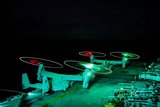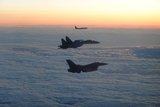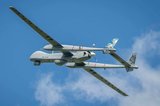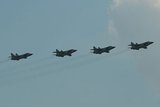Taiwan navy adds two new warships as China tensions grow
Taiwanese President Tsai Ing-wen vowed 8 November that the island would not ‘concede one step’ in defending itself as she inaugurated two frigates bought from the United States aimed at boosting Taipei's naval capabilities against China.
Rival China has upped military drills including a live fire exercise in the Taiwan Strait in April, declaring its willingness to confront the island's ‘independence forces’.
Beijing still claims self-ruled Taiwan as part of its territory awaiting reunification, by force if necessary, even though the two sides have been ruled separately since 1949 after a civil war.
China has also been incensed by recent warming ties between Washington and Taipei, including the US State Department's approval of a preliminary licence to sell submarine technology to the island.
The two Perry-class guided missile frigates were officially commissioned in a ceremony at Zuoying base in southern Kaohsiung city.
‘We want to send a clear and firm message from Taiwanese people to the international community that we will not concede one step in defending... Taiwan and protecting our free and democratic way of life,’ Tsai said after inspecting the ships.
China's ‘military actions in the region not only attempt to weaken Taiwan's sovereignty but will also damage regional peace and stability,’ Tsai warned.
She vowed to continue enhancing the navy's capabilities as part of the military's goal to maintain what it calls ‘solid defence and multi-layered deterrence’ to guard the island.
Navy chief of staff Vice Admiral Lee Chung-hsiao had said previously the warships' anti-submarine capabilities are more advanced than the island's existing eight Cheng Kung-class frigates and could have ‘deterrent effects’ against China's submarines.
The US de facto embassy in Taipei, the American Institute in Taiwan (AIT), said the sale would ‘improve Taiwan's capability in current and future defensive efforts’ as well as stability in the region.
The ships will be deployed to patrol the Taiwan Strait, the narrow waterway that separates the island and China, according to the navy.
Beijing has stepped up diplomatic and military pressure on Taiwan since Tsai took office two years ago, as her government refuses to acknowledge that Taiwan is part of ‘one China’, unlike the government of her Beijing-friendly predecessor.
In September, Washington irked Beijing when it announced plans to sell Taiwan $330 million in spare parts for several aircraft.
Washington remains Taipei's most powerful unofficial ally and its main arms supplier despite switching diplomatic recognition to Beijing in 1979.
Built in the 1980s, the two frigates were originally named USS Taylor and USS Gary and were part of a $1.8 billion US arms deal to Taiwan announced in 2015 under the administration of US president Barack Obama.
They have been renamed Ming Chuan and Feng Chia.
According to Taiwan's navy, the warships have ‘high mobility, high sea resistance and low noise’ and are fitted with the SQR-19 sonar system currently used by US navy.
More from Defence Notes
-
![Why the NORAD inventory might be the US and Canada’s Achilles’ heel]()
Why the NORAD inventory might be the US and Canada’s Achilles’ heel
Both the US and Canada operate Cold War-era capabilities which cannot defeat today’s and tomorrow’s threats.
-
![Companies’ results boom as countries dig deep to buy missiles and air defence systems]()
Companies’ results boom as countries dig deep to buy missiles and air defence systems
Air defence systems are continuing to appear top of countries’ shopping lists but broadly across different capabilities it is a sellers’ market, as demonstrated by backlogs and double-digit percentage point growth.
-
![Forging strong partnerships for warfighting communications in space (Studio)]()
Forging strong partnerships for warfighting communications in space (Studio)
Mike Moran, Director of US Government Business at Amazon Project Kuiper Government Solutions, highlighted the evolution of space as a critical warfighting domain at the Defence in Space Conference (DISC) 2025, held this week in London.
-
![Details revealed on Germany’s big spending plans]()
Details revealed on Germany’s big spending plans
In May this year, German Chancellor Friedrich Merz said the government plans to position Germany as “Europe's strongest conventional army”. A new blueprint outlines how this is going to occur through massive investment.
-
![European Council to deliver at “pace and scale” on European defence readiness 2030 roadmap]()
European Council to deliver at “pace and scale” on European defence readiness 2030 roadmap
Two of the concrete projects outlined in the readiness report, the European Air Shield and Space Shield, will aim to be launched by Q2 2026.























